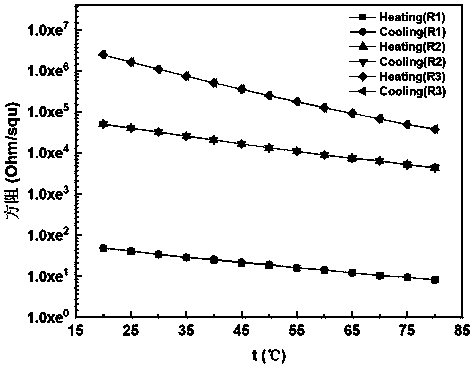Thermosensitive film and preparation method and application thereof
A heat-sensitive thin-film and thin-film technology, applied in thin-film resistors, vacuum evaporation plating, coating, etc., can solve problems affecting device stability, high noise, thermal hysteresis loops, etc., and achieve easy control and preparation of resistance The process is simple and easy, and the effect of long-term stable electrical performance
- Summary
- Abstract
- Description
- Claims
- Application Information
AI Technical Summary
Problems solved by technology
Method used
Image
Examples
Embodiment approach 1
[0025] Put the K9 glass substrate into acetone, alcohol, and deionized aqueous solution in order to ultrasonically clean it. After blowing dry with nitrogen, put the substrate into a DC reaction magnetron sputtering furnace, and pump the background vacuum to 1×10 -3 Pa. During this time, the substrate was heated to 200°C. The substrate was blocked by a baffle, and the metal zinc target was pre-sputtered for 10 min with an argon gas flow rate of 100 sccm and a sputtering current of 0.4 A. After the pre-sputtering, keep the argon gas flow rate at 100 sccm and the sputtering current constant, add the oxygen flow rate at 5 sccm, and the working pressure at 1.0 Pa, remove the baffle, and sputter on the substrate for 30 min. During the sputtering process, keep the substrate The rack rotates at a constant speed. After the sputtering is completed, the oxygen flow, the argon flow and the sputtering current are simultaneously turned off. After the sputtering furnace is stabilized, t...
Embodiment approach 2
[0029] Put the K9 glass substrate into acetone, alcohol, and deionized aqueous solution in order to ultrasonically clean it. After blowing dry with nitrogen, put the substrate into a DC reaction magnetron sputtering furnace, and pump the background vacuum to 1×10 -3 Pa. During this time, the substrate was heated to 200°C. The substrate was blocked by a baffle, and the metal zinc target was pre-sputtered for 10 min with an argon gas flow rate of 100 sccm and a sputtering current of 0.4 A. After pre-sputtering, keep the argon gas flow rate at 100 sccm and the sputtering current constant, add the oxygen flow rate at 5 sccm, and the working pressure at 1.0 Pa, remove the baffle, and sputter on the substrate for 20 min. During the sputtering process, keep the substrate The rack rotates at a constant speed. After the sputtering is completed, the oxygen flow, the argon flow and the sputtering current are simultaneously turned off. After the sputtering furnace is stabilized, the b...
Embodiment approach 3
[0032] Put the K9 glass substrate into acetone, alcohol, and deionized aqueous solution in order to ultrasonically clean it. After blowing dry with nitrogen, put the substrate into a DC reaction magnetron sputtering furnace, and pump the background vacuum to 1×10 -3 Pa. During this time, the substrate was heated to 200°C. The substrate was blocked by a baffle, and the metal zinc target was pre-sputtered for 10 min with an argon gas flow rate of 120 sccm and a sputtering current of 0.3 A. After pre-sputtering, keep the argon gas flow rate at 120 sccm and the sputtering current constant, add the oxygen flow rate at 15 sccm, and the working pressure at 1.3Pa, remove the baffle, and sputter on the substrate for 40 min. During the sputtering process, keep the substrate The rack rotates at a constant speed. After the sputtering is completed, the oxygen flow, the argon flow and the sputtering current are simultaneously turned off. After the sputtering furnace is stabilized, the b...
PUM
 Login to View More
Login to View More Abstract
Description
Claims
Application Information
 Login to View More
Login to View More - R&D
- Intellectual Property
- Life Sciences
- Materials
- Tech Scout
- Unparalleled Data Quality
- Higher Quality Content
- 60% Fewer Hallucinations
Browse by: Latest US Patents, China's latest patents, Technical Efficacy Thesaurus, Application Domain, Technology Topic, Popular Technical Reports.
© 2025 PatSnap. All rights reserved.Legal|Privacy policy|Modern Slavery Act Transparency Statement|Sitemap|About US| Contact US: help@patsnap.com



